Key highlights
- UK consumer spending in 2022 was 21% higher than in 2021 as the post-pandemic boom meets inflation
- takepayments data predicts the UK will spend 15% more in 2023
- Spending in restaurants and bars shot up in 2022, while other industries declined
- People are spending more on travel as UK restrictions relaxed
- The increase in the price of fuel drove a drop in the rate of new car sales
- Wholesalers are seeing increased demand as shoppers reduce their spending in convenience stores and newsagents
- Spending in Northern Ireland grew twice as fast as the UK average
- The East of England struggled to recover compared with other UK regions
- The cost of living crisis hits Scottish households hard as spending per capita is the lowest in the UK
2022 was a tricky year for both businesses and shoppers in the UK. The ongoing recovery of the high street following the pandemic was set back by the energy crisis triggered by conflict in Ukraine. Households felt the sting of high utility costs and skyrocketing fuel prices. Consumers and businesses reprioritised spending as the nation braced itself for a possible recession.
But it's not all bad news. The UK has narrowly avoided a recession at the end of 2022, and original data from takepayments’ card and POS system transaction data around the country shows that some industries and regions are rapidly growing. As champions of UK small and independent businesses, we dug in to discover why some enterprises succeed amid adversity and what we might learn to support others in the coming year.
The Spending Index below compiles all of our key findings and provides insight into what businesses might expect going into 2023.
UK spending grew 21% in 2022
Our data shows that the amount spent in 2022 was 21% higher than in 2021.
Even when factoring in the early 2021 lockdown, the growth is substantial. Between July 2021 (the month after the UK government lifted all lockdown measures) and December 2022, spending grew by 15%, consistently increasing each month. The only exception was December 2021, when spending declined by 1.1%.
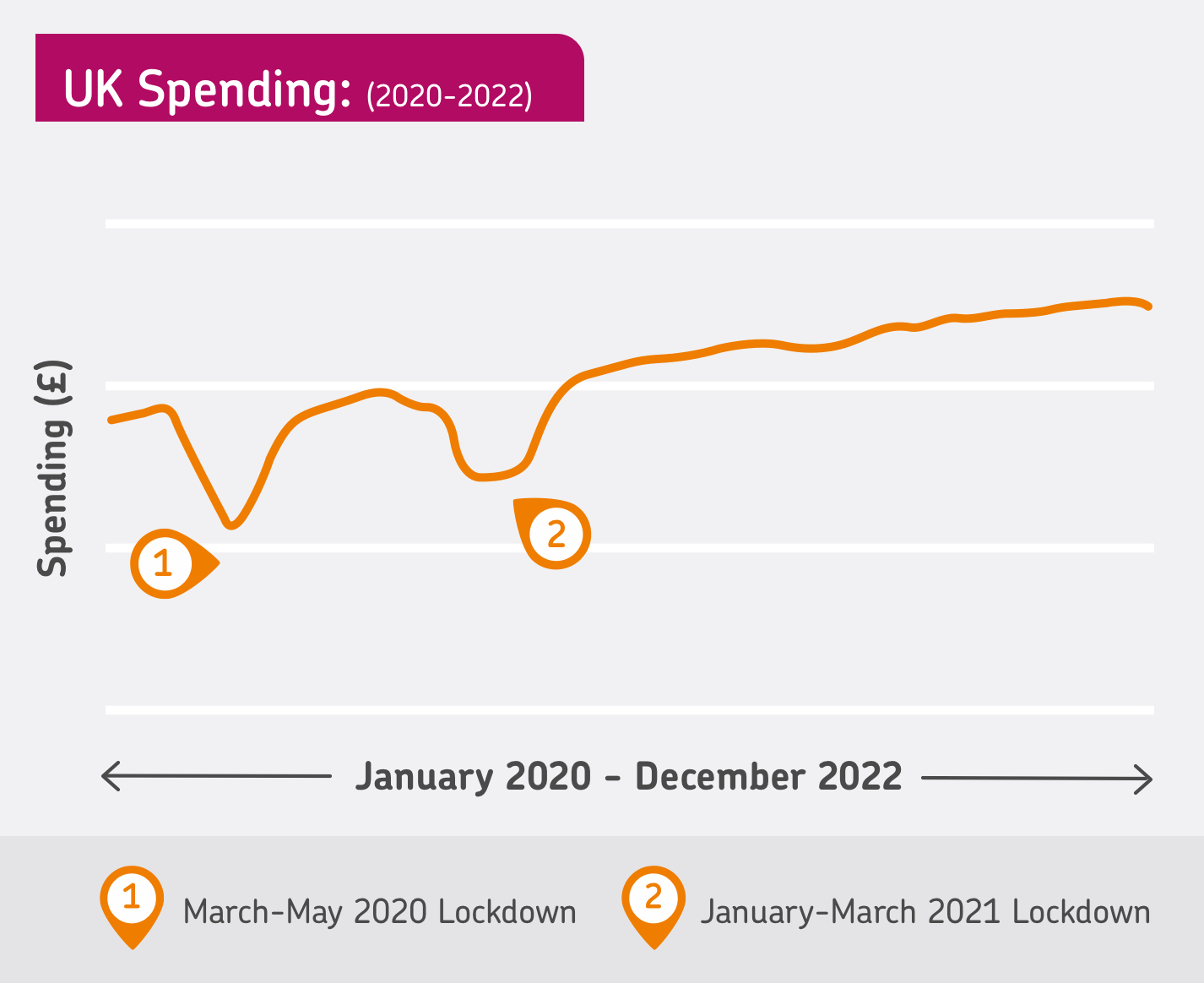

This spending rate outpaces the inflation rate, which was recorded at 10.5% in December 2022 (Source: ONS Consumer Pricing Index). It also goes against the grain regarding new businesses: while spending was up, 2022 recorded a 1.47% decline against 2021 in the rate of UK startups being registered (Source: Gov.uk).
We also noted that wage growth did not match inflation rates in 2022. Between September and November, growth in average total pay was 6.4%, but growth in real terms fell 2.6% on the year, one of the most significant falls in growth “since comparable records began in 2001” (Source: ONS).
Spending is forecasted to increase a further 15% in 2023
When predicting spending for 2023 based on our transactions data from 2022, our forecast projected a further increase of 15% compared with 2022.
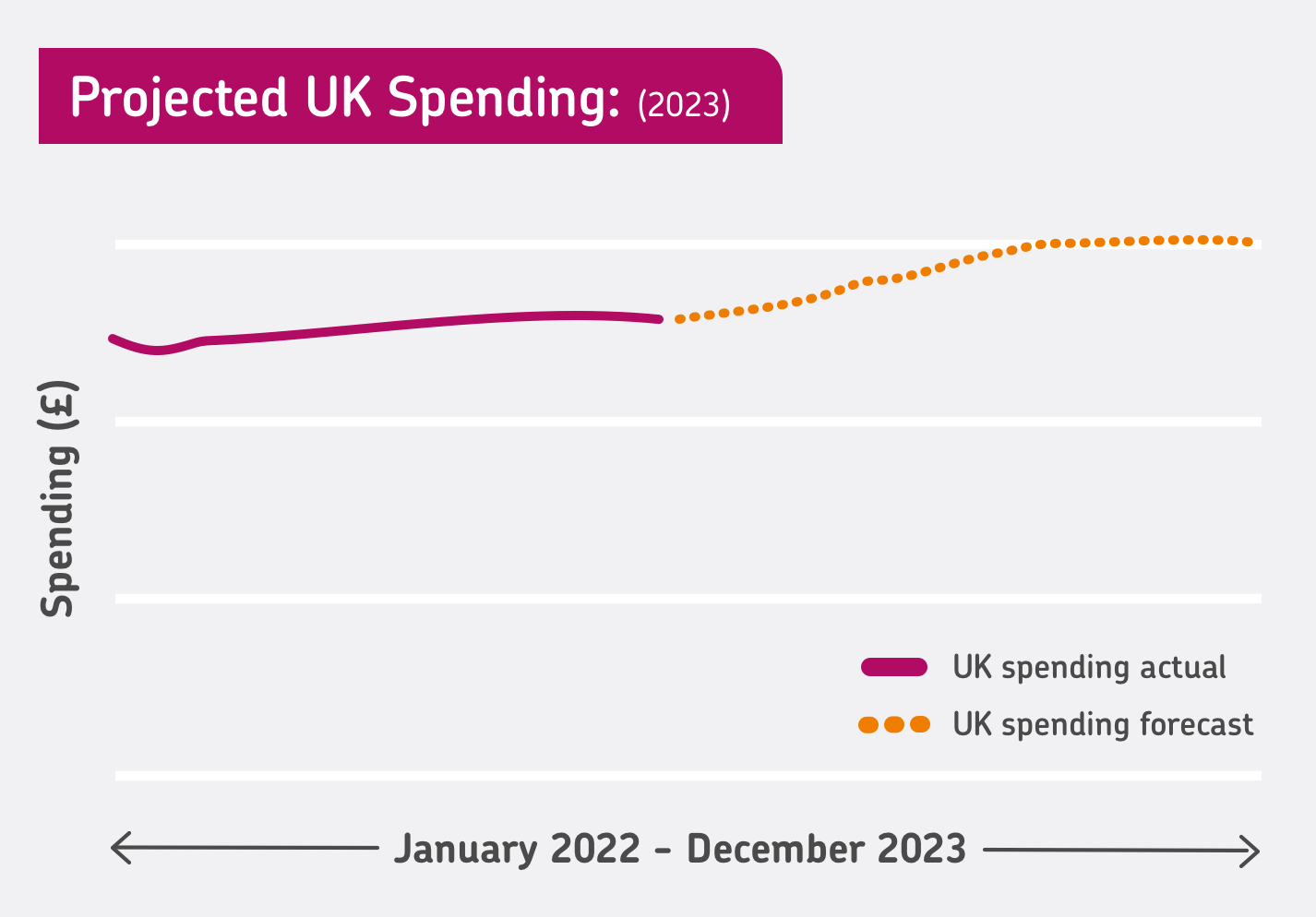

Note: We based our forecast on the average month-on-month change for each calendar month over the complete data set, which we applied from the last available month of data (December 2022).
Aside from rising costs, the potential for wage growth is a key contributing factor to further spending increases. XpertHR predicts 91% of UK employees will receive a pay rise in 2023. Salaries could jump as high as 15% in some professions, but XpertHR expects the UK average to be between 3.5% and 6%.
Additionally, the National Institute of Economic and Social Research forecasts a rapid fall in inflation from February 2023 — though it will remain well above 3% for the whole of 2023.
RSM UK predicts that the cost of living crisis will likely last until the second half of 2023 when inflation starts dropping sharply: this is because the 2022 surge in energy prices will become the year-on-year baseline.
It’s possible that our predicted 15% spending increase could represent a real-terms decline when adjusted for inflation. The Bank of England predicts a recession in 2023, and energy costs will rise again by 20% in April.
How have UK industries been affected?
We broke down our card and POS transactions data by industry to see how the pandemic recovery and cost of living crisis impacted businesses in the various sectors we serve.
While several industries saw a gradual decline in spending throughout 2022, others fared much better. Sectors like hospitality, travel and wholesale saw significant spending increases following the lifting of all UK lockdown measures in June 2021, displaying growth that stayed strong despite the economic turbulence of the year that followed.
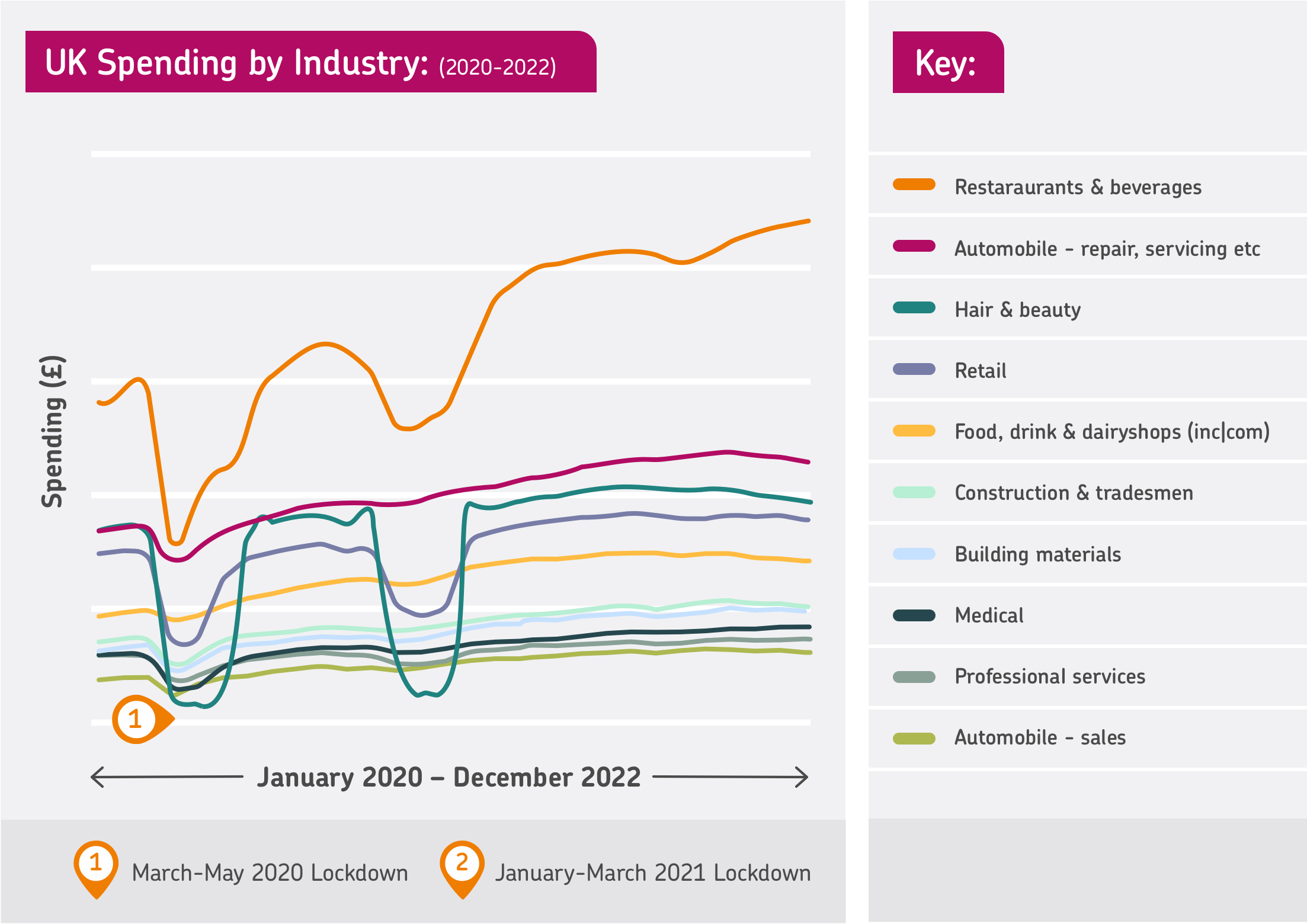

Brits continue to spend big in restaurants and bars despite higher costs
Spending in the Restaurants and Beverages category shot up 20% in 2022 compared with 2021, which in turn saw a 31% increase following 2020.
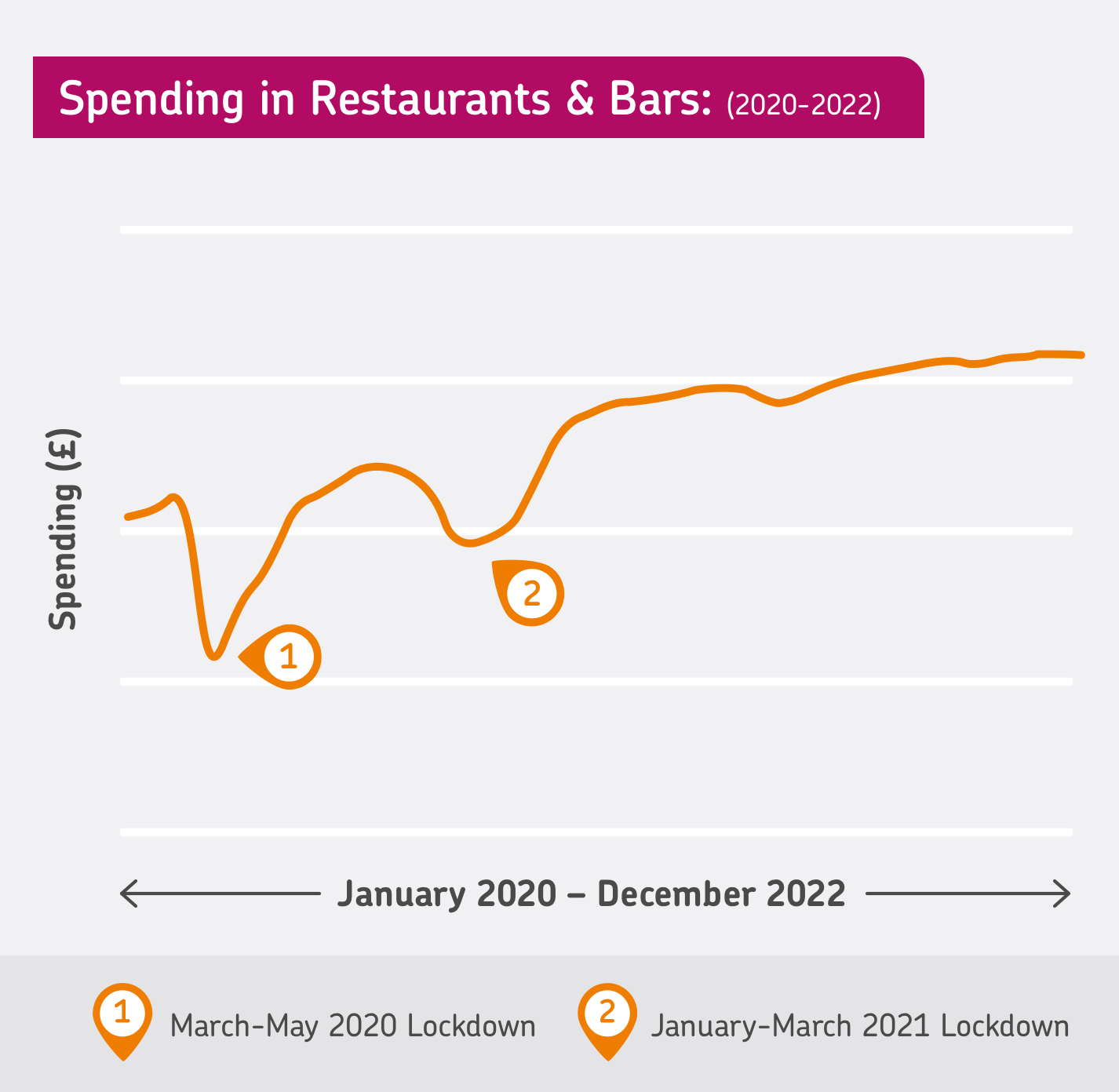

Despite the increasing cost of food and drink in 2022, UK consumers continued to dine out together, a social activity bolstered by the winter World Cup that ran through November and December. The ONS recorded a 0.4% growth in output for consumer-facing services in November 2022, stating that "the largest contribution to growth came from food and beverage service activities in a month where the FIFA World Cup started" (Source: ONS).
The growth in activity also correlates with a boom in new hospitality businesses recorded throughout 2022. The rate of new company registrations in the Accommodation & Food category saw an almost 5% increase in 2022 compared with 2021 (Source: ONS).
However, 2023 could be a more challenging year for the hospitality sector. Nearly 90% of consumers will be looking to save money when eating out next year as discretionary income falls, according to new forecasts from IGD's Eating In Vs Eating Out report. Additionally, the Bidfood and CGA 2023 Trends consumer survey found that more than half of those surveyed (53%) were planning on eating out less in 2023 than they did before, with 48% saying they'd go out for drinks less.
People are spending more on travel post-lockdown
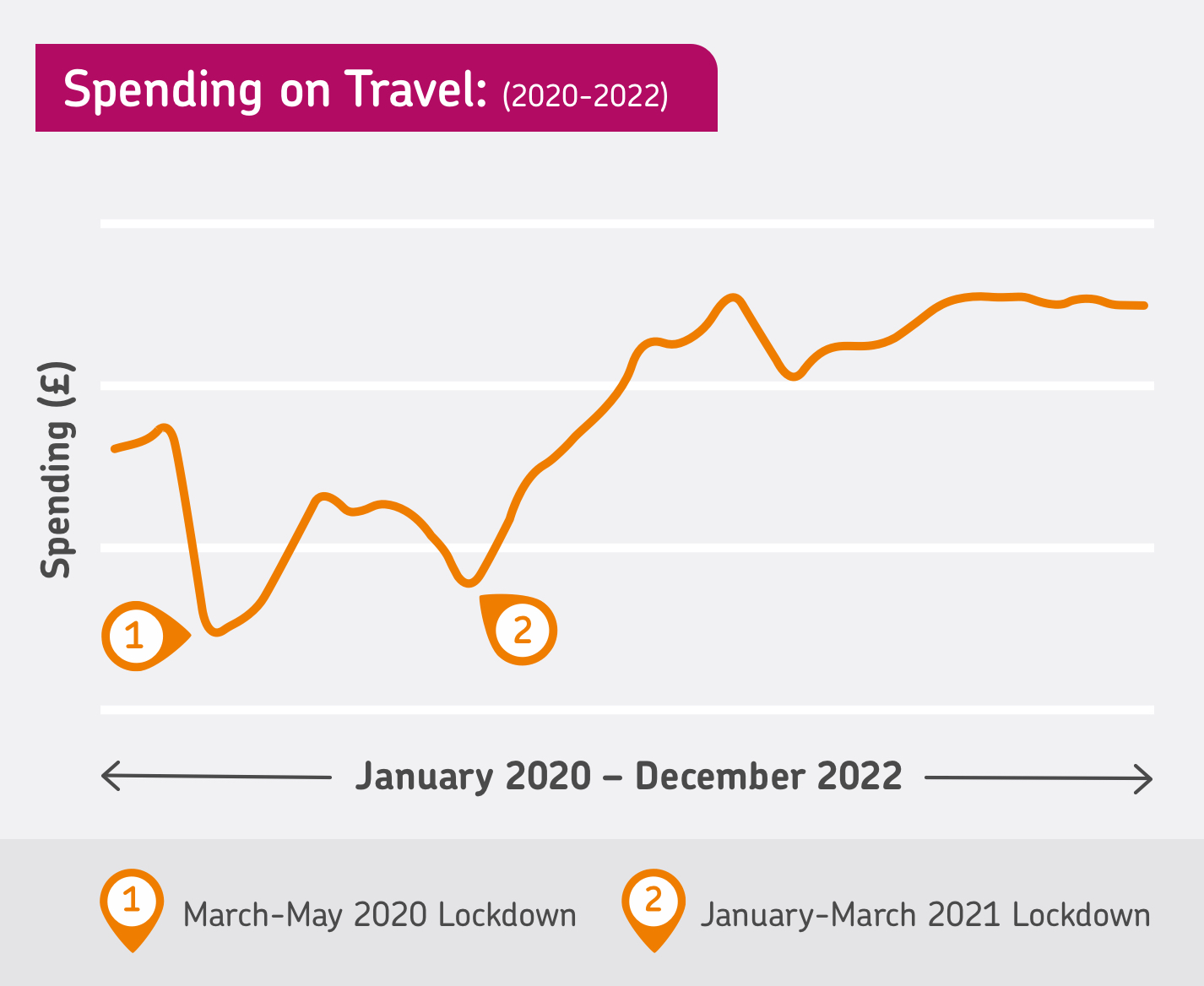

Our data showed that consumers spent 32% more on travel in 2022 than in 2021.
A significant contributing factor to the increase is the travel lockdowns that were in effect at the start of 2021. Even so, spending on travel in Q4 of 2022 was up almost 10% compared to 2021, when there were no travel restrictions.
Another critical factor at play is the rise in costs associated with travel. By the end of 2022, prices for business travel were up 26% versus the previous year. While these costs are relatively stable compared with the steeper year-on-year increases of as much as 50% in summer, prices will likely continue rising in 2023.
Despite these increasing costs, 61% of Brits interviewed by ABTA in its Holiday Habits report said they were still planning on a holiday abroad in 2023. ABTA's research found that 29% of people plan to take an all-inclusive holiday in 2023 to help them manage their finances, rising to 40% among those aged 44 and under, and 57% of young families.
Hotels also saw a jump in spending in 2022; takepayments data showed a year-on-year increase of more than 10%. This increase in spending is primarily influenced by the increasing prices that customers and businesses face in this sector.
Room charges could increase further in 2023. PwC predicts that the UK's average revenue per available room could jump up 5% in 2023 compared with 2022 — and by nearly 25% in some parts of London.
We're spending more on fuel... but less on new cars
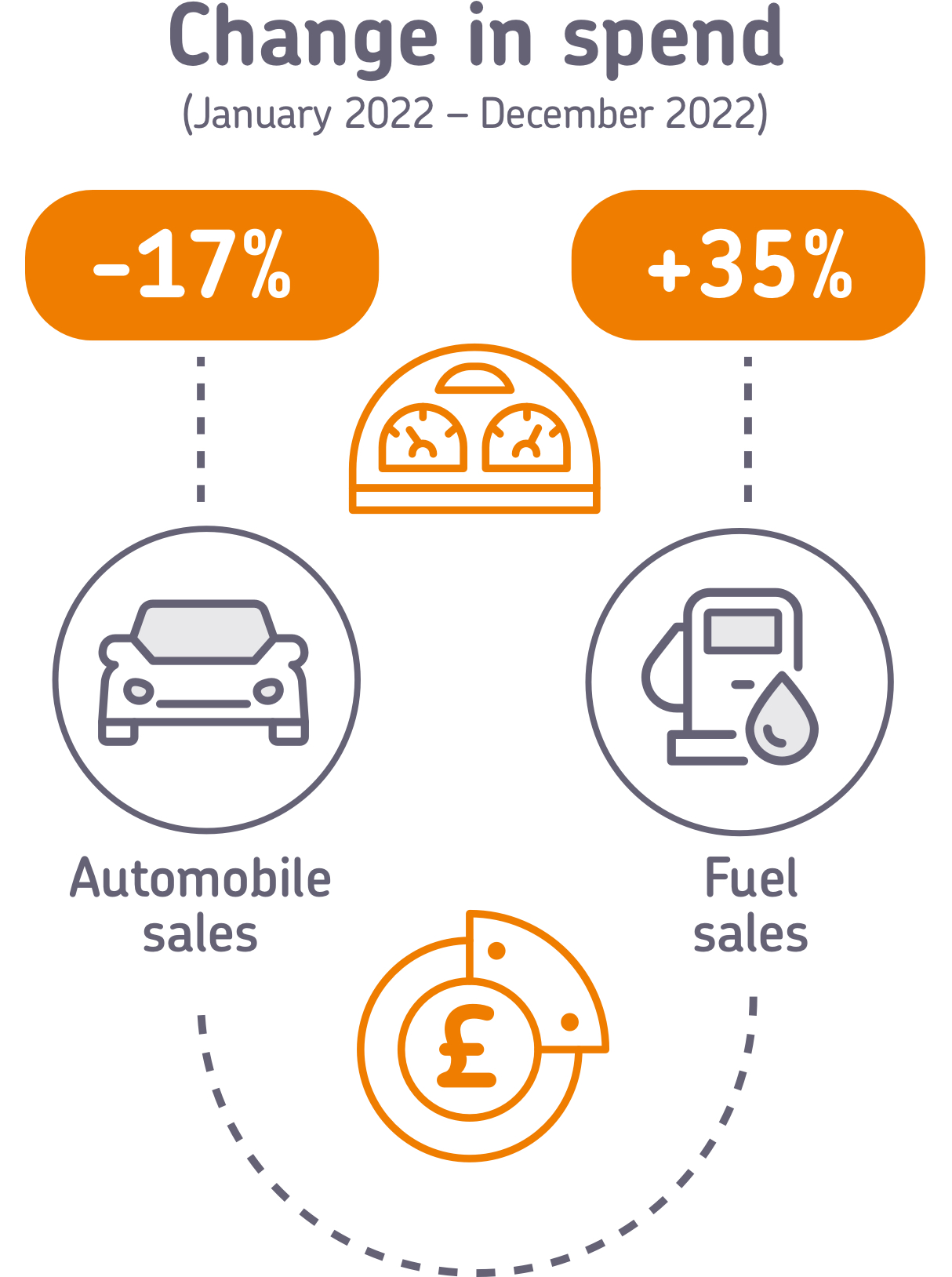

Between January and December 2022, spending recorded by takepayments’ card and POS systems transactions for businesses in the Automobile Sales category declined by 17%, while fuel spending in December was 35% higher than it was in January.
Of course, fuel prices across the country rose significantly throughout 2022. Fuel spending increased by 21% in 2022 compared with 2021, and in December 2022, the average tank of fuel cost 11.5% more than it did the previous year. That's significantly less than the peak in July, which saw year-on-year increases at an eye-watering 44% (Source: ONS).
But did the fuel cost crisis trigger a drop in demand for new cars? SMNT revealed that 2022 showed declines in new car registrations compared with 2021, the most significant decrease being in June 2022 — during the peak of the fuel crisis — when registrations dropped by almost a quarter year-on-year. SMNT credits some of this decline to ongoing global supply chain issues, predominantly the lack of semiconductors, which continued to impact order fulfillment. The sources of these disruptions were the Covid lockdowns in China and disruption from the war in Ukraine, choking the supply into the UK market.
Additionally, takepayments data showed a drop in spending for Haulage and Courier businesses, which saw year-on-year declines of 4% and 3% in 2022. These drops align with the nationwide challenges in logistics following a mass exodus of HGV following Brexit. These challenges persisted in 2022: the Charted Institute of Logistics and Transport found that almost 80% of haulage businesses were experiencing a shortage in HGV drivers, and 4 in 5 of the top haulage companies surveyed by Haul Exchange believe that volatile fuel prices are the biggest challenge they'll face in 2023.
The shortage of HGV drivers has, in turn, had a significant impact on other industries. Our previous research into the staffing and supply crisis in November 2021 found that half of small businesses had experienced supply chain issues that year. Over two-thirds predicted these issues would persist throughout 2022.
People are avoiding the “convenience tax” on grocery shopping
One interesting trend we observed from the takepayments spending data was that newsagents saw declines in spending during 2022 (down 15%), while wholesalers saw incomes jump (up 16%).
These were two of the least-affected sectors during the lockdowns of 2020 and 2021. Since food was on the government's list of essential items, businesses in this sector were allowed to remain open.
But in 2022, the cost of living crisis negatively impacted newsagents as consumers kept a closer eye on their budgets. Additionally, the rise of hybrid working means fewer employees leaving their homes to go to the office, where many "convenience purchases" (like lunch) are typically made.
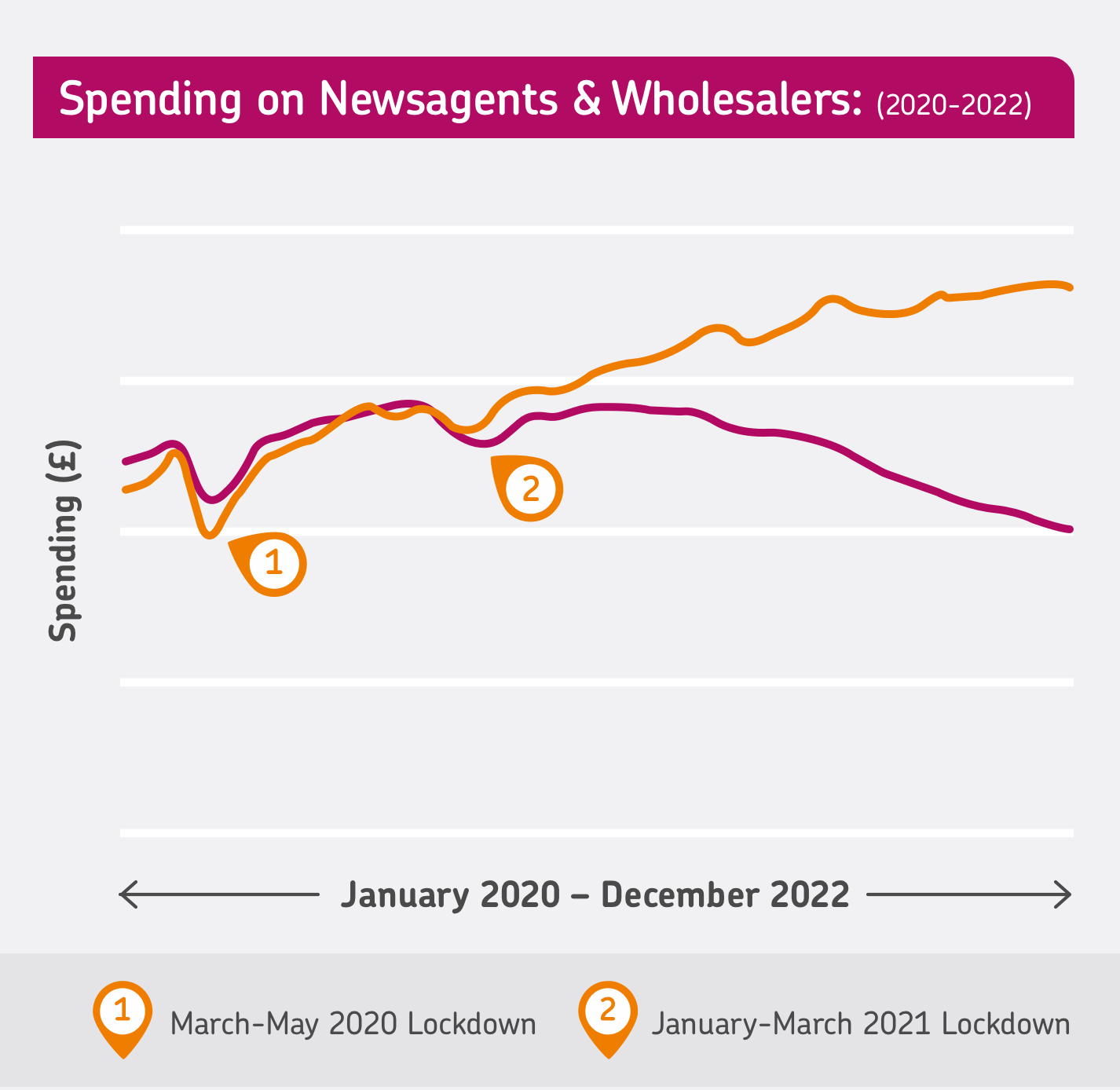

The data suggests the possibility of people buying their food in bulk to save money overall. Purchases from Food and Drink businesses (excluding newsagents) increase 2.5% year-on-year according to the takepayments data; these stores may, in turn, be spending more at wholesalers to keep up with demand.
Other studies also imply that UK attitudes toward grocery shopping have changed. Data from Lumina Intelligence (reported on in Talking Retail) found that while shoppers visited convenience stores more in the first half of 2022, they spent, on average, almost 12% less, indicating they only called for the essentials. Another study from KPMG found that 3 in 5 of consumers plan to cut discretionary spending in 2023, and a third of respondents plan to buy fewer items per shop to save money.
How does spending differ by region in the UK?
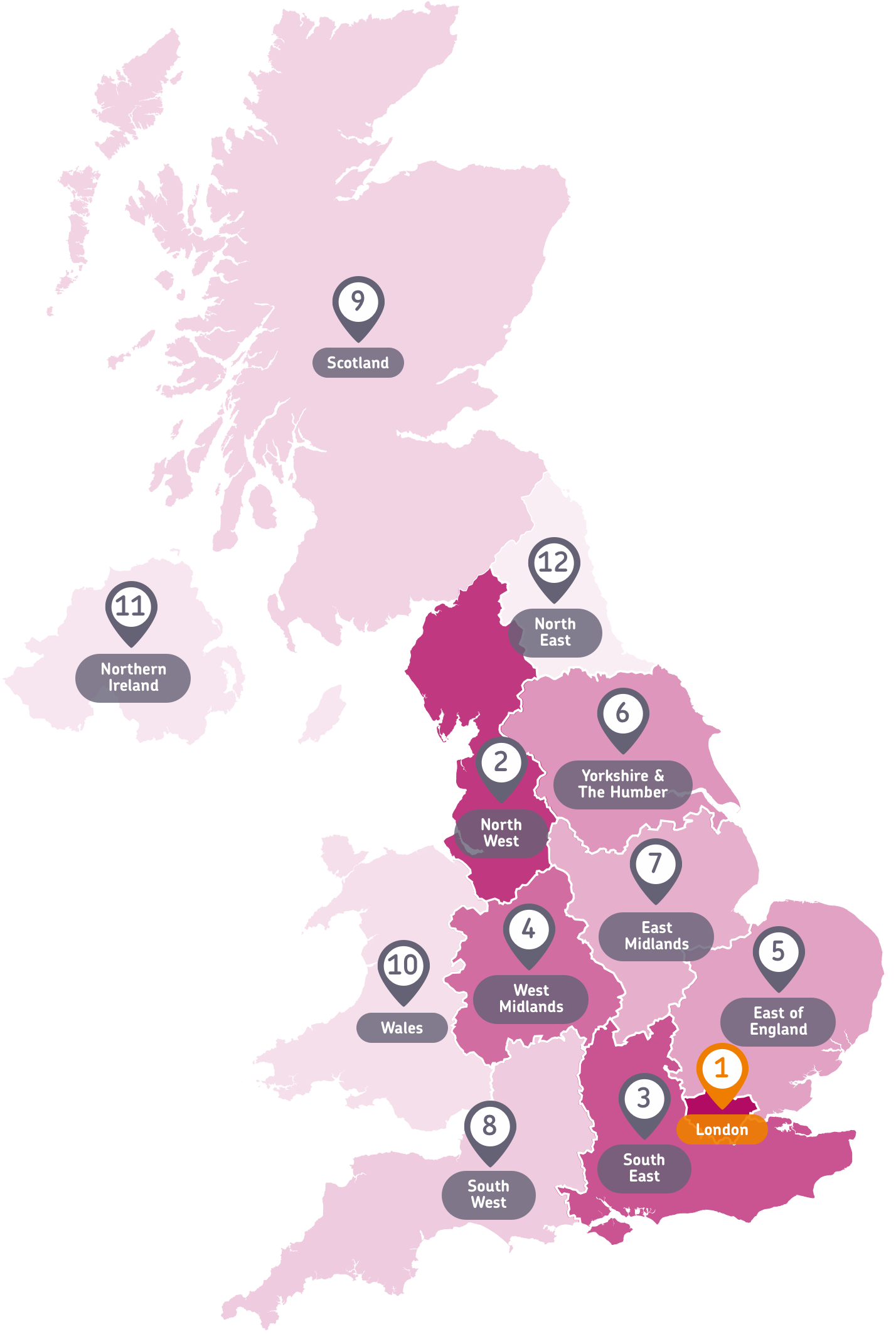
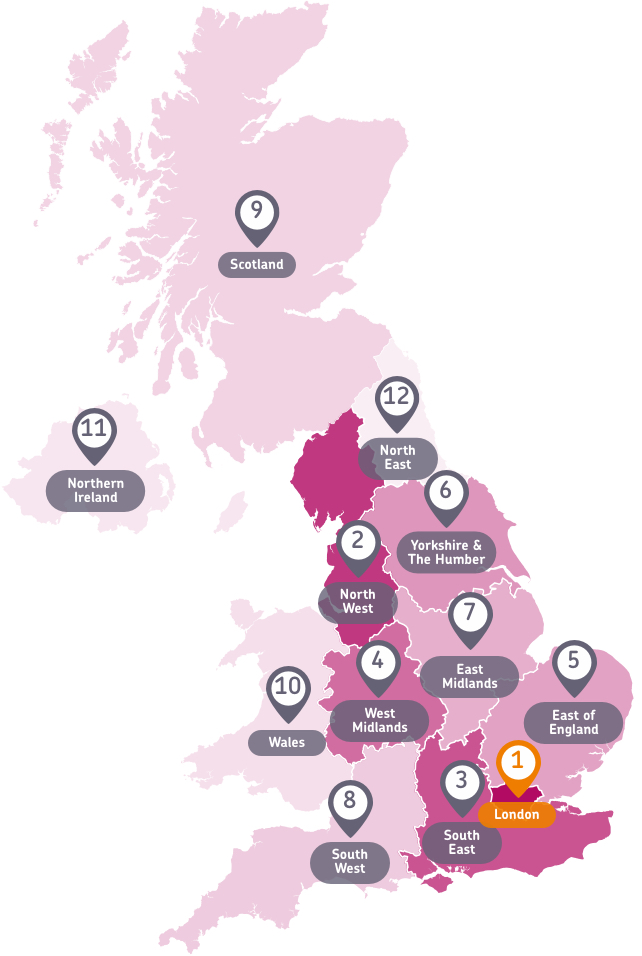
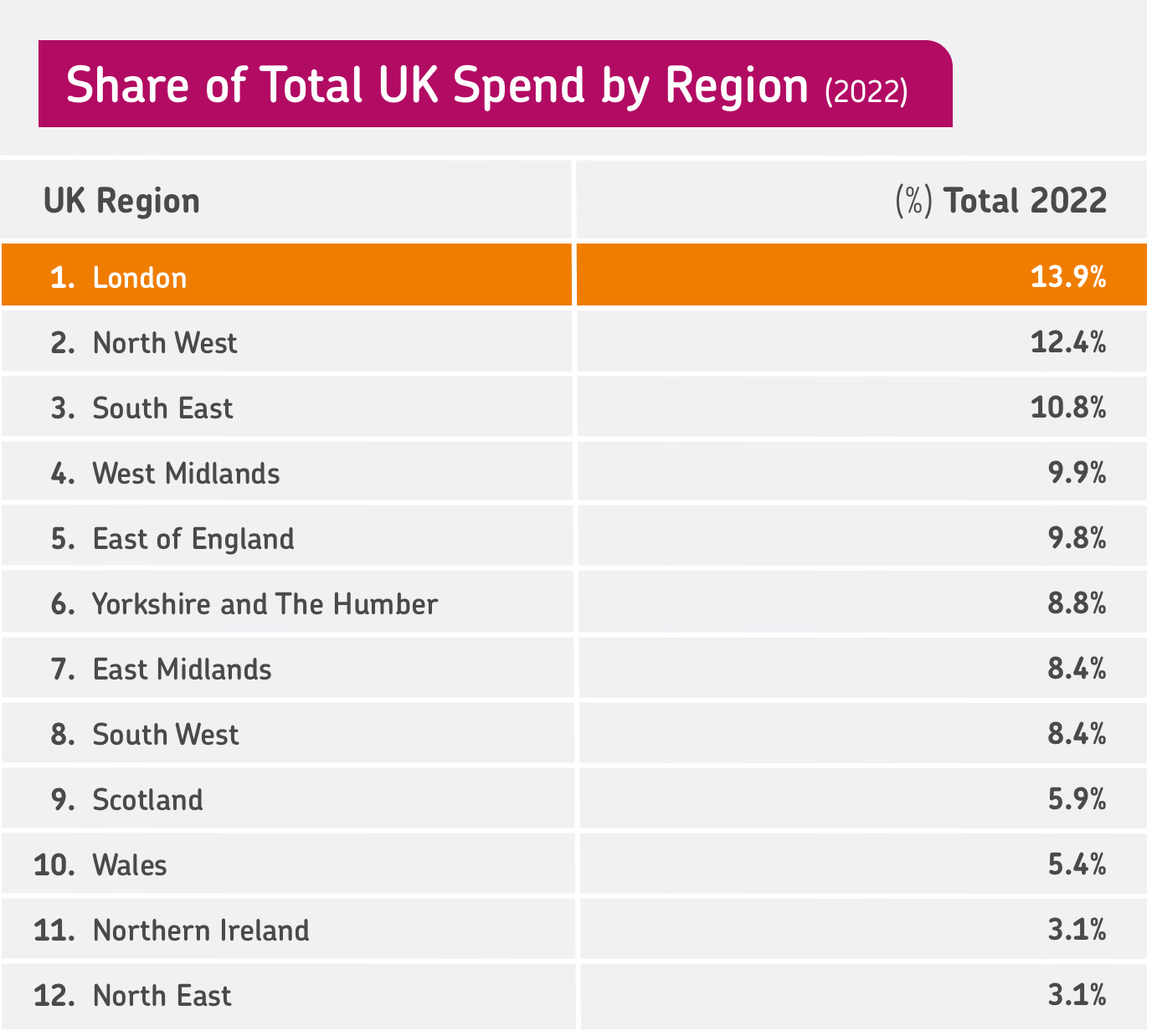

The challenges of the last three years have impacted almost everyone in the UK. But location can impact a business's revenue almost as much as the industry to which it belongs. And with the pandemic putting a spanner in the works of the government's levelling-up project, we wanted to examine just how much difference there is between the UK's main regions in 2022 — and whether the divide is increasing or decreasing.
The Institute for Public Policy Research (IPPR) concluded in its January 2023 report that "[t]he UK continues to stand out internationally for the wrong reason: because it is the most regionally unbalanced large, advanced economy."
We wanted to see whether the takepayments data reinforced this assessment — and whether there were some positive takeaways to report for 2023.
London regains ground as the UK’s economic hub despite remote working
Despite the rise of remote working during and after the pandemic, London's economy gained key ground in 2022. It remained the highest-spending region in the country, increasing its share of the UK's total spending by 10%. The capital grew from a 12.62% share of the UK economy in 2021 to 13.92% the following year.
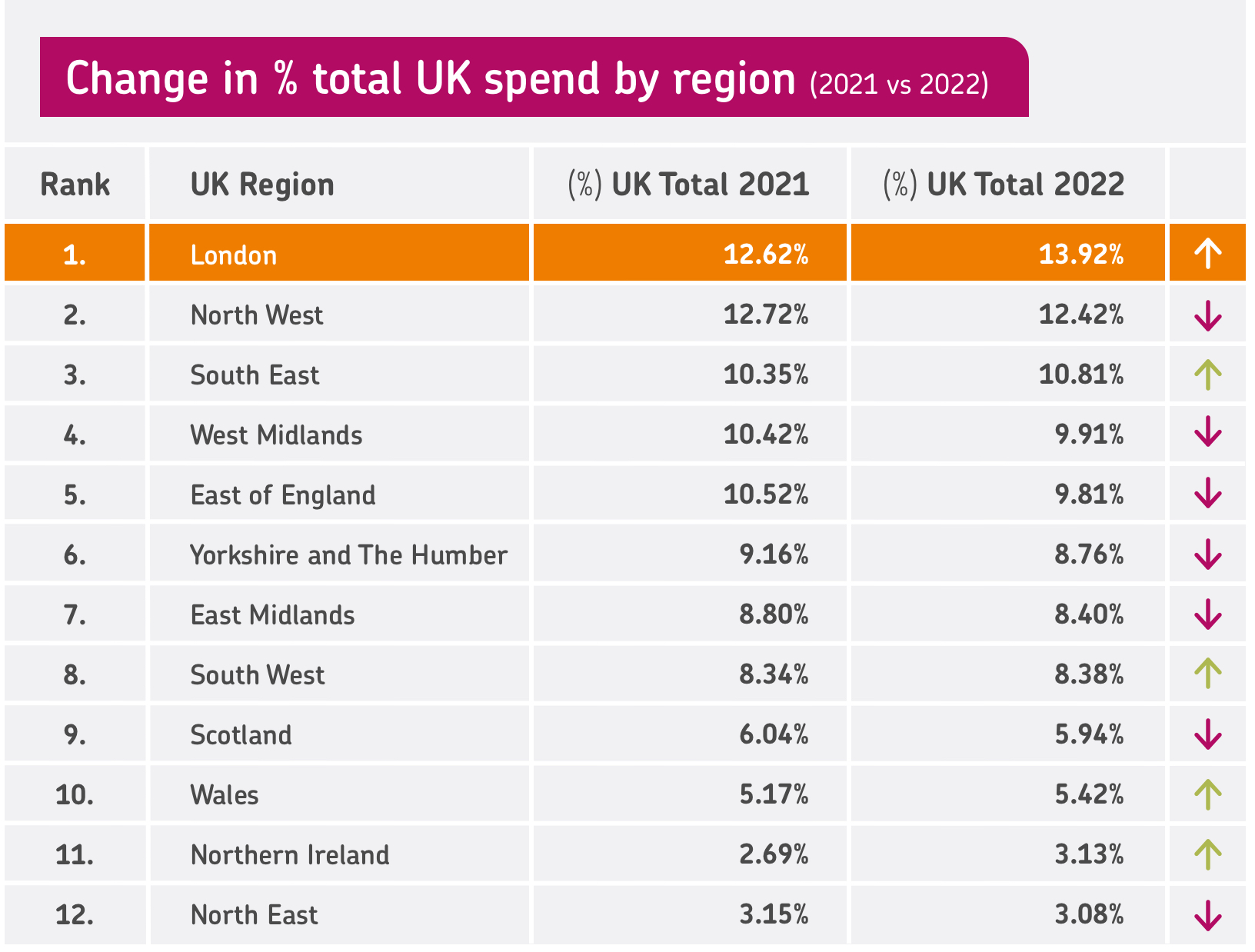

London gained ground over the North West, its main economic competitor, despite government plans for "levelling up".The UK government has allocated around £590 million to projects in the North West through the Levelling Up Fund and Community Ownership Fund (Source: Gov.uk). But it appears the cost of living crisis has exasperated the divide, with lower-earning regional employees unable to compete with the resources available to London-based companies.
Other studies have come to similar conclusions. Natwest's UK Regional PMI report for December 2022 found that London outperformed other UK regions in economic growth. It recorded growth and the highest score on the PMI Business Activity Index (52.0). At the same time, the North West saw no change (50.0), and all other regions other than Wales recorded a contraction in activity.
And it isn't slowing down. The takepayments data shows that London was also the fastest-growing region in Q4 (5.2%). According to the London Chamber of Commerce and Industry, the following was true of Q4 2022:
- 22% of London businesses reported an increase in domestic sales
- 1 in 10 London businesses reported an increase in their workforce size
- 17% of London businesses expect to increase the size of their workforce by the end of March 2023
- More than a third (37%) of London businesses expect their profitability to improve over the coming 12 months.
It remains to be seen whether 2023 will bring the relative stability needed to distribute spending away from London. Still, the data shows the capital remains the safest bet for potential investors.
Northern Ireland was the fastest-growing UK region in 2022
While London may have recorded the largest share of the UK's spending, it was only second on our table of the fastest-growing region. For that prize, Northern Ireland came out on top, recording a 41% increase in year-on-year spending for 2022 — nearly double the average growth rate of 21%.
Northern Ireland also overtook the North East in spending in 2022. It recorded a 3.13% share of total UK spending in 2022 — compared to 2.69% the previous year — putting it above the North East, which recorded a 3.08% share.
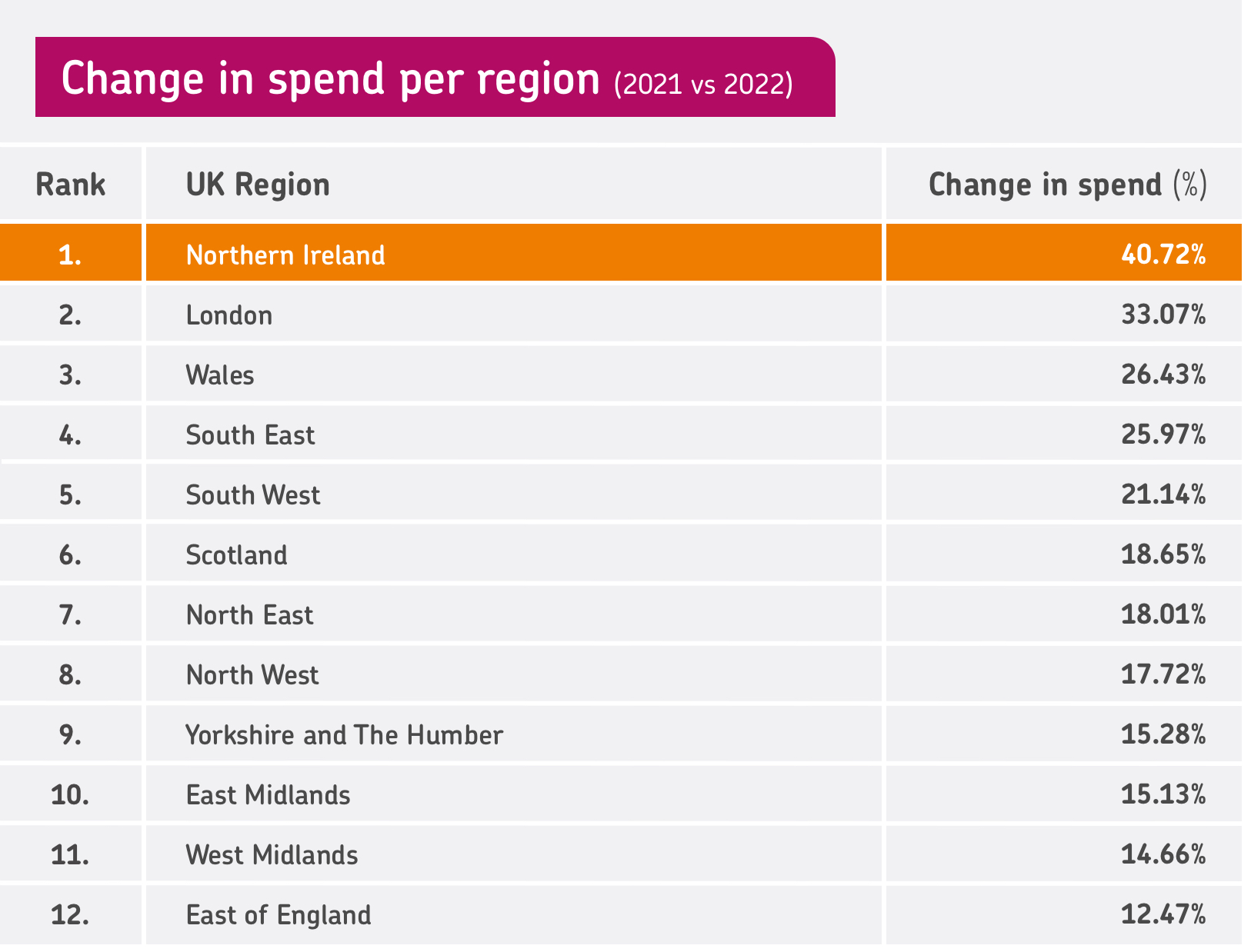

According to ONS business population estimates for 2022, Northern Ireland had the second-largest growth in newly registered businesses (the first being Wales), with a year-on-year increase of 3.64%. An analysis of Creditsafe data conducted by Northern Ireland-based firm R3 found that 8,325 new businesses were registered in the region throughout the year, representing impressive growth.
Furthermore, the NI Statistics and Research Agency (Nisra) declared that Northern Ireland's economic output was at a 15-year high in the summer of 2022, just 0.1% behind the record output level in mid-2007. Northern Ireland grew enormously over the previous three years, with output up by 4.8% compared to the UK's average GDP growth of 1.3%.
However, things look less rosy for Northern Ireland in 2023. Northern Ireland posted the worst contraction of business activity of any region in December 2022, according to Natwest's PMI Business Activity Index. Firms in Northern Ireland also recorded the steepest rise in input prices in December.
That said, the introduction of the Windsor Framework, announced in February 2023, could spell better fortune for Northern Irish trade. The bill, which will serve as an override to the old Northern Ireland protocol, is designed to make it easier for NI businesses to import and export goods to the UK and the EU, reducing turnaround times and costs. That could play a pivotal role in helping Northern Irish businesses stay strong in 2023.
The East of England grew the slowest in 2022
On the other end of the growth scale is the East of England, which struggled to recover as quickly as the other regions on our list. Our data showed a growth of just over 12% in 2022, compared with the UK average of 21%.
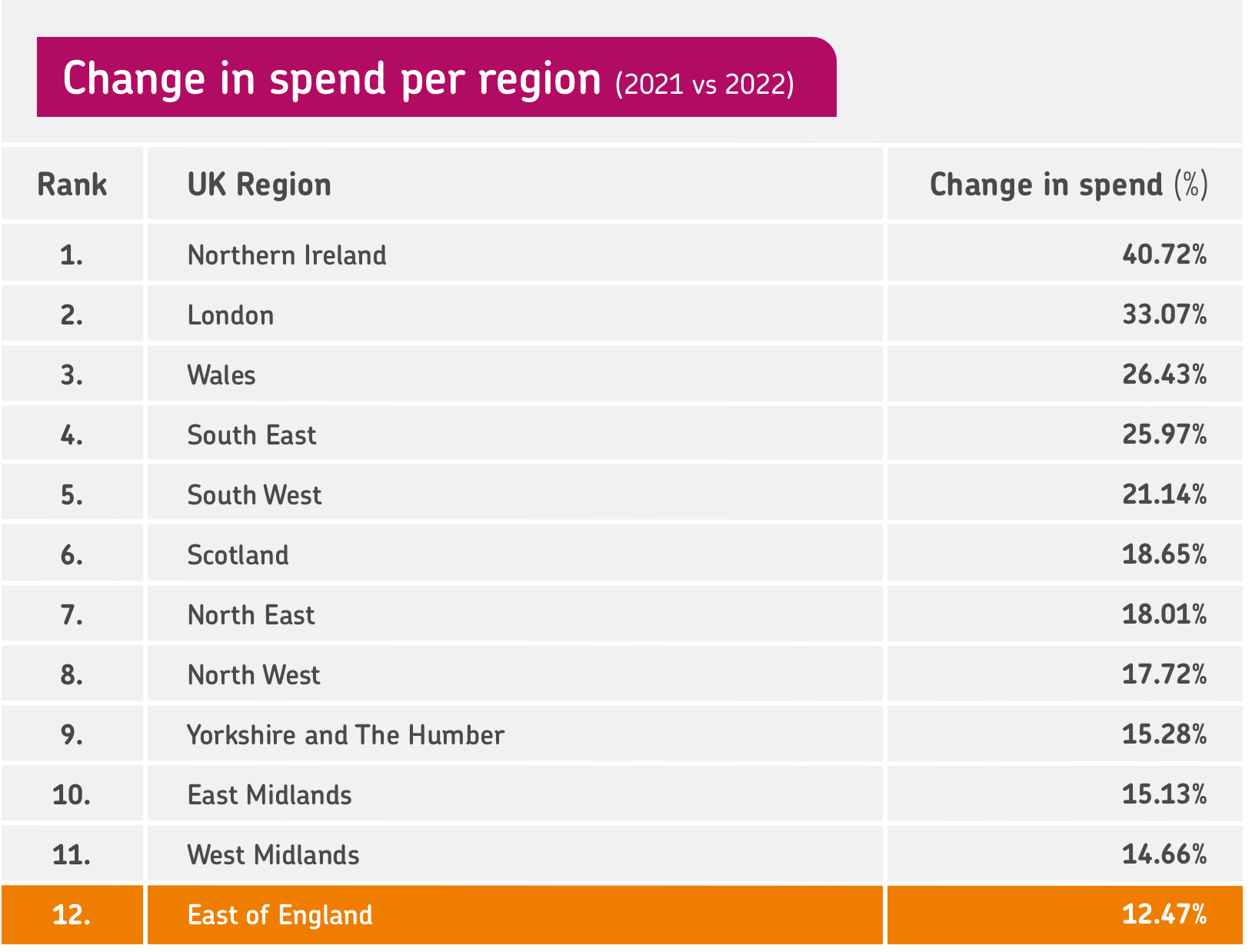

The East of England saw a decline in new businesses of -4.37% in 2022 vs 2021, the second-biggest drop in the UK. The first was Yorkshire and The Humber, which posted a -6.75% decline (Source: Gov.uk).
And things look pretty much the same for the East in 2023. A study by Towergate Insurance found that Norwich, one of the region's most populous urban areas, is considered the UK's most at-risk city for business closures in 2023. The percentage of small businesses at risk of closure this year is 74% — 28% higher than the UK average.
Scotland was the only region to see a decline in Q4 2022
Overall, Q4 of 2022 was a pleasant surprise for many economists. The UK narrowly avoided entering a recession despite predictions that it would, closing out the year on a high.
But this was different on a region-by-region level. Our data found that spending in Scotland declined in Q4 compared with Q3: it was the only region that recorded a quarterly drop in expenditure.
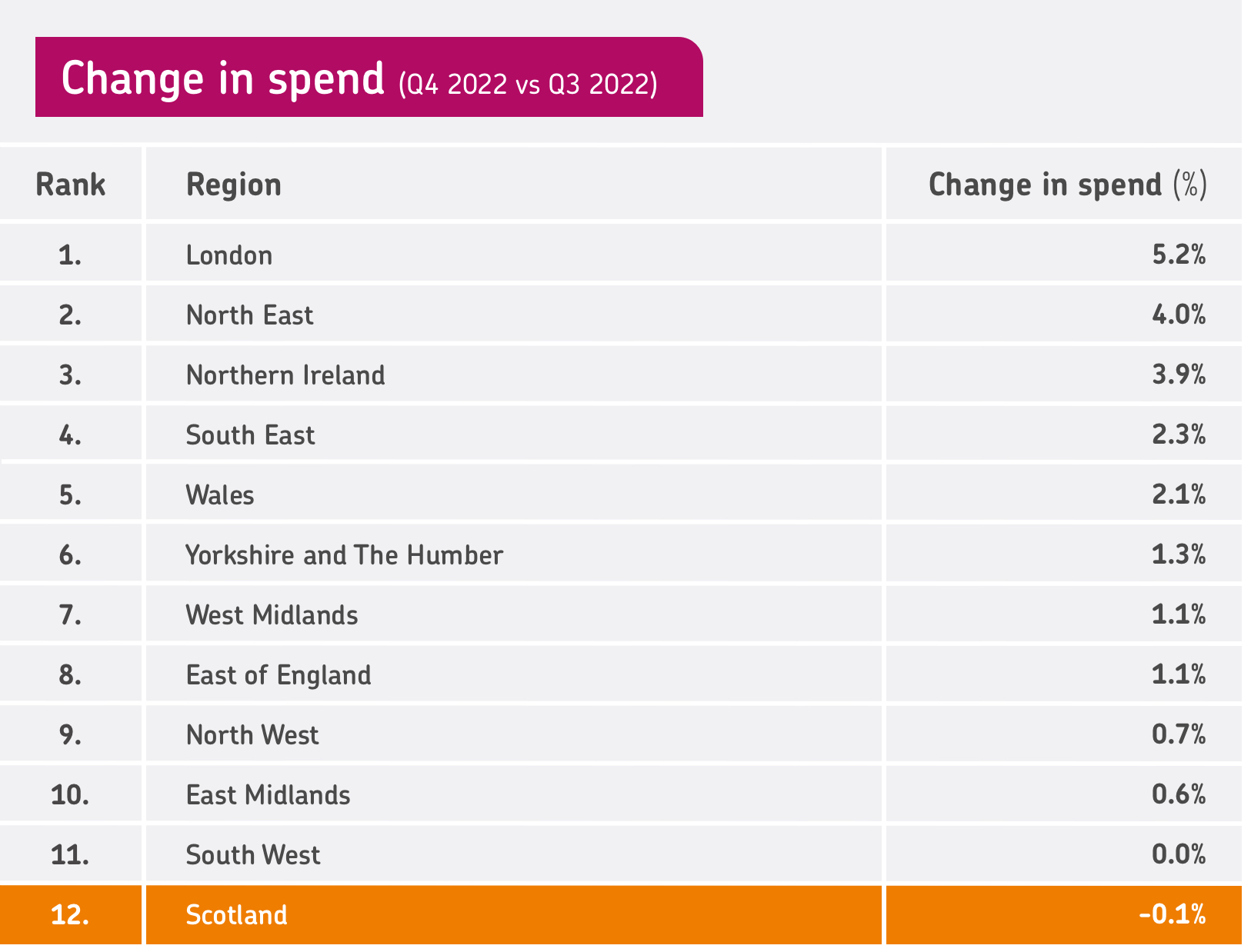

Scotland also had the lowest spending per person in any UK region in 2022. Its per-capita expenditure was 39% less than East Midlands, which came top of the pack.
Scottish high streets struggled disproportionately to recover from the pandemic lockdowns, according to the takepayments High Street Index. Furthermore, the Scottish government found that Scottish confidence in the economy in Q4 was at its "lowest level for the overall indicator since records began in 2013".
Unlike England, Wales, and Northern Ireland, experts at the Scottish Fiscal Commission believe Scotland entered a recession in late 2022 (Source: Scotland’s Economic & Fiscal Forecasts December 2022 - February 2023 Revised Version).
What will 2023 bring?
Jodie Wilkinson, Head of Strategic Partnerships at takepayments, says that the data could be a warning sign for UK businesses — particularly SMEs — that the coming twelve months will bring plenty of headwinds."Looking at the data, it's clear that 2022 has been a challenging year for businesses of all sizes around the country," says Jodie. "It’s great to see significant increases in spending in some industries and regions, but the news is dampened by weak year-on-year comparisons and record inflation.
However, Jodie feels there’s plenty of reason to be encouraged. “Predictions that inflation rates could drop off in 2023 would spell good news for those businesses that have felt the pinch in their input costs. This year could spell some much more positive outcomes for the UK’s small business population.
“The rapid growth of regions like Northern Ireland and the continued strength of London business shows that even in the midst of economic pressure, there are still opportunities for small businesses to thrive. It’s also reassuring to see that Brits continue to support local bars and restaurants with record spending. We hope to see the healthy rate of new business registrations in that sector continue to stay strong.”
Find out why thousands of businesses choose takepayments below.
More insights from takepayments
Want more original statistics about UK businesses and consumer behaviours? Check out these other data reports and tools from our team:
- Tipping in the UK: Consumer Attitudes Survey
- The Highstreets Bouncing Back Post-Lockdown Index
- Sole Trader Tax Calculator

